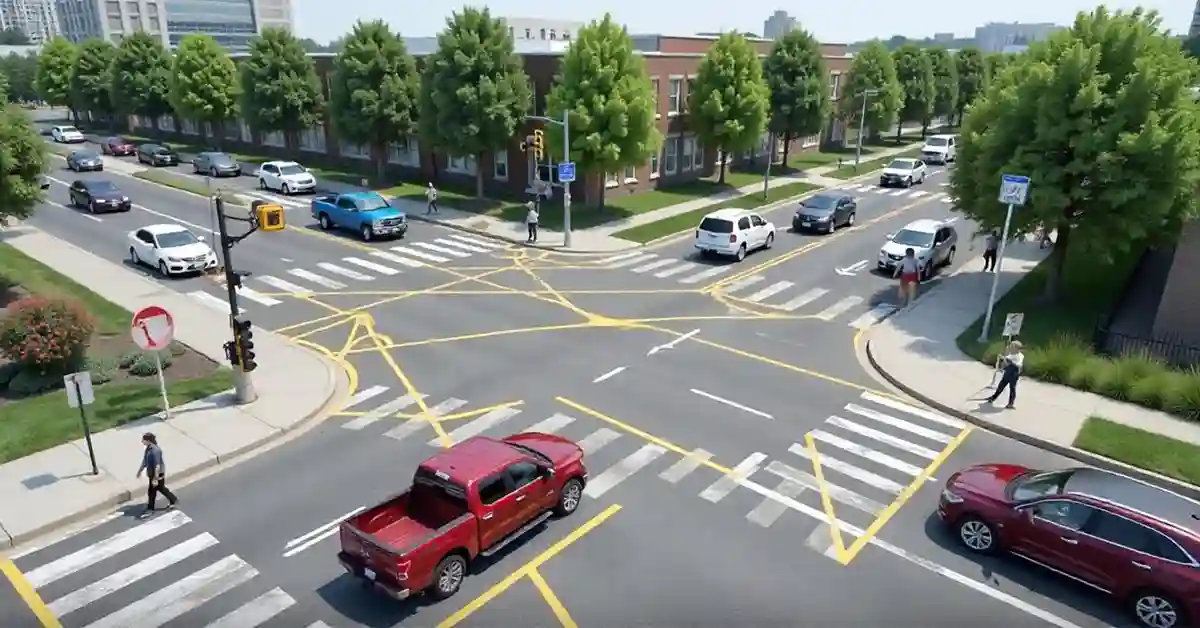In 2014, Virginia became home to an exciting and innovative solution to traffic congestion with the introduction of the Continuous Flow Intersection (CFI). Designed to streamline the flow of vehicles, this concept has captured the attention of transportation enthusiasts, civil engineers, and local commuters alike. But what makes the continuous flow intersection so captivating and why did it become such a hot topic in Virginia?
What exactly are the main aspects of the “Virginia Times Continuous Flow Intersection 2014”? How does it differ from traditional intersections, and what problems does it aim to solve? These questions guide our exploration of this innovative traffic solution. At its core, the CFI allows for smoother transitions and fewer interruptions for drivers, potentially reducing congestion and improving traffic efficiency. By adapting to changing traffic patterns, it aims to offer a smoother driving experience.
The continuous flow intersection presents potential solutions to common traffic woes, such as long wait times and bottlenecks. By examining its structure, functionality, and benefits, we can better appreciate its impact on modern transportation. Let’s explore how this design promises to revolutionize roadways and improve commuting experiences for all.
The Birth of a Game-Changer
Virginia’s introduction of the Continuous Flow Intersection (CFI) in 2014 marked a significant change in the way intersections function. Traditional intersections often cause delays and congestion due to the complex interaction of multiple traffic streams. CFIs, however, offer a new approach by allowing certain movements to occur simultaneously, reducing wait times and improving traffic flow.
The concept of the CFI is not entirely new. It has been implemented in other parts of the world with great success. By adopting this design, Virginia aimed to address its unique traffic challenges and improve the everyday commuting experience for its residents.
Core Features of a Continuous Flow Intersection
A continuous flow intersection is designed to minimize conflict points and streamline traffic movement. It achieves this by diverting left-turning vehicles before they reach the intersection, allowing them to cross opposing traffic lanes in advance. This innovative approach eliminates the need for a dedicated left-turn signal phase, leading to more efficient traffic management.
Beyond the reconfiguration of left-turn lanes, CFIs also incorporate additional elements such as dedicated pedestrian crossings and traffic signal optimization. By integrating these features, CFIs ensure that both vehicles and pedestrians can move safely and efficiently through the intersection.
Understanding Traffic Dynamics
One of the primary benefits of a continuous flow intersection is its ability to reduce traffic congestion. By allowing certain movements to occur simultaneously, CFIs minimize the interruptions caused by traditional signal phases. This results in smoother traffic flow and shorter wait times for drivers.
In addition to improving traffic movement, CFIs enhance safety by reducing the number of conflict points within the intersection. By eliminating the need for left-turn signals, CFIs also reduce the chances of rear-end collisions and other common intersection accidents.
Virginia’s Role in Pioneering CFIs
Virginia’s decision to implement continuous flow intersections was driven by a commitment to enhancing transportation infrastructure. Recognizing the potential benefits of CFIs, state officials collaborated with transportation experts to ensure successful implementation.
The installation of CFIs was part of a broader effort to address traffic congestion and improve overall road safety. By investing in innovative solutions, Virginia aimed to set an example for other states to follow in their pursuit of modern traffic management strategies.
A Closer Look at Design
The design of a continuous flow intersection may appear complex at first glance, but it offers a logical and efficient approach to traffic management. CFIs are characterized by their unique lane configurations, which allow for smoother transitions and improved traffic flow.
One key element of CFI design is the pre-signal that guides left-turning vehicles to cross opposing lanes before reaching the intersection. This reduces the need for dedicated left-turn phases and minimizes delays caused by traditional traffic signals.
Pedestrian Considerations
While CFIs are primarily designed to improve vehicular traffic flow, they also incorporate features to enhance pedestrian safety. Dedicated pedestrian crossings are strategically placed to ensure that pedestrians can cross safely without disrupting vehicular movement.
In addition to clearly marked crossings, CFIs often include pedestrian signals and refuge islands to provide a safe and efficient passage for pedestrians within the intersection.
The Role of Technology in CFIs
Technology plays a vital role in the functioning of continuous flow intersections. Advanced traffic signal systems are employed to optimize traffic flow and ensure seamless coordination between different movements.
By utilizing real-time data and adaptive signal control, CFIs can respond to changing traffic conditions and adjust signal timings accordingly. This enhances the overall efficiency of the intersection and minimizes delays for drivers.
The Impact on Daily Commutes
For local commuters, the introduction of continuous flow intersections has brought about noticeable improvements in daily travel experiences. Reduced wait times and improved traffic flow have made daily commutes more predictable and less stressful.
CFIs are particularly beneficial in areas with high traffic volumes, where traditional intersections often struggle to handle the demand. By streamlining traffic movement, CFIs help to alleviate congestion and improve overall road network efficiency.
Environmental Benefits of CFIs
Continuous flow intersections offer environmental benefits by reducing vehicle idling and emissions. With smoother traffic flow and fewer stops, vehicles spend less time idling at intersections, leading to decreased fuel consumption and lower emissions.
By promoting efficient traffic movement, CFIs contribute to cleaner air and a more sustainable transportation system. This aligns with broader efforts to reduce the environmental impact of road transportation.
Addressing Challenges and Concerns
While CFIs offer numerous benefits, they also present certain challenges and concerns. One common concern is the potential for driver confusion during initial implementation. However, with proper signage and education, these concerns can be addressed effectively.
Public awareness campaigns and clear instructions help drivers understand how to navigate CFIs safely and confidently. Over time, familiarity with the design leads to improved compliance and a smoother transition for all road users.
The Role of Public Engagement
Successful implementation of continuous flow intersections requires active public engagement and collaboration. Engaging with local communities, gathering feedback, and addressing concerns are essential steps in ensuring the success of CFIs.
Public engagement initiatives provide valuable insights into the needs and preferences of local commuters, allowing transportation agencies to tailor CFI designs to meet specific requirements.
The Future of Intersection Design
The success of continuous flow intersections in Virginia has sparked interest in their wider adoption across the United States. As more states explore innovative traffic management solutions, CFIs are likely to become an integral part of modern intersection design.
By leveraging technology, data-driven insights, and community involvement, future intersection designs will continue to evolve, offering safer and more efficient transportation networks.
Lessons Learned from Virginia’s Experience
Virginia’s experience with continuous flow intersections provides valuable lessons for other regions considering similar implementations. Key takeaways include the importance of thorough planning, effective communication, and ongoing evaluation.
By learning from Virginia’s successes and challenges, other states can develop tailored CFI solutions that address their unique traffic needs and improve overall road safety.
FAQs With Answers
What is a continuous flow intersection (CFI)?
A continuous flow intersection (CFI) is an innovative traffic management design that allows certain movements to occur simultaneously, reducing wait times and improving traffic flow. It achieves this by diverting left-turning vehicles before they reach the intersection, minimizing conflict points.
What are the benefits of continuous flow intersections?
Continuous flow intersections offer several benefits, including reduced traffic congestion, improved safety due to fewer conflict points, and enhanced pedestrian accommodations. They also contribute to environmental sustainability by reducing vehicle idling and emissions.
How do continuous flow intersections enhance safety?
Continuous flow intersections enhance safety by reducing the number of conflict points within the intersection. By eliminating the need for dedicated left-turn phases, CFIs minimize the chances of rear-end collisions and other common intersection accidents.
How can public engagement improve CFI implementation?
Public engagement is crucial for the successful implementation of continuous flow intersections. Engaging with local communities, gathering feedback, and addressing concerns help tailor CFI designs to meet specific needs and ensure smooth transitions for all road users.
What lessons can other states learn from Virginia’s experience with CFIs?
Other states can learn valuable lessons from Virginia’s experience with continuous flow intersections. Key takeaways include the importance of thorough planning, effective communication, and ongoing evaluation to ensure successful implementation and improved road safety.
Conclusion
The introduction of continuous flow intersections in Virginia in 2014 marked a significant advancement in traffic management. By offering innovative solutions to longstanding traffic challenges, CFIs have transformed the way intersections operate and improved daily commuting experiences.
The success of CFIs in Virginia highlights the importance of forward-thinking transportation solutions that prioritize efficiency, safety, and sustainability. As more states explore the potential of continuous flow intersections, the future of intersection design holds exciting possibilities for creating safer and more efficient road networks.
In the quest for improved transportation infrastructure, continuous flow intersections stand as a testament to the power of innovation and collaboration. By leveraging technology and engaging with local communities, transportation agencies can pave the way for a brighter and more connected future on the road.



